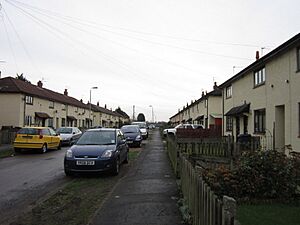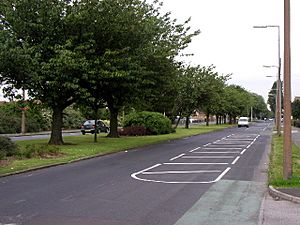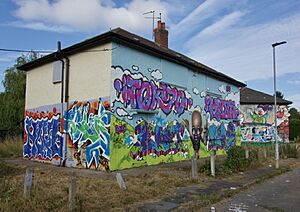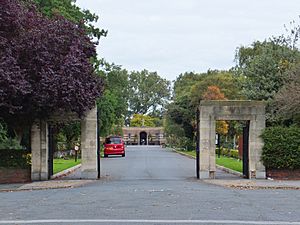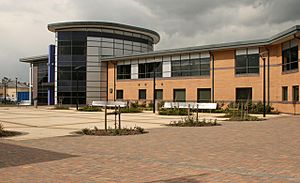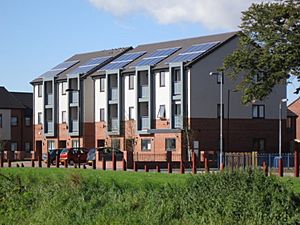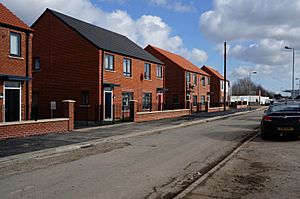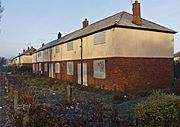Preston Road Estate facts for kids
The Preston Road Estate, also called the East Hull Estate, is a large neighbourhood in the eastern part of Kingston upon Hull, England. It was built mostly between the 1920s and 1940s by the local council, Hull Corporation. In the early 2000s, the area saw big changes. Many older homes were updated or replaced, and a large community centre was built.
The Eastern Cemetery, which opened in 1931, is located at the east side of the estate. It was built around the same time as the first houses. One of the most notable buildings in the area is the large Archbishop Sentamu Academy school.
Contents
Exploring the Preston Road Estate's Location
The Preston Road Estate is in the south-eastern part of Hull, on the east side of the River Hull. It sits between two main roads: Holderness Road (the A165) and Hedon Road (the A1033). The main road running through the estate is Preston Road, which is a dual carriageway.
This road crosses the Holderness Drain, a large water channel, roughly in the middle of the estate. The modern Archbishop Sentamu Academy and the "Freedom Centre" community hub are both near this crossing.
The area is mainly homes, with some playing fields and gardens where people grow plants. The land is very flat and is less than 5 metres (about 16 feet) above sea level.
To the west is Southcoates, and to the north-west are Summergangs and Holderness Road. To the north-east is the Bilton Grange Estate, and to the east is the Greatfield Estate. All these areas are mostly housing.
South of the estate, the land changes to industrial areas. These areas support the Alexandra Dock and King George Docks. You can also find Hull Prison and the old village of Marfleet here. The southern edge of the estate follows a cycle path, which used to be a railway line.
In 2011, about 47% of the homes were semi-detached, and 40% were terraced houses. At that time, many people in the area were unemployed. About 61% of the homes were social housing (rented from the council or a housing association), and 30% were owned by the people living in them.
The History of Preston Road Estate
How the Estate Was Built (Before 1945)
In 1850, the land where the estate now stands was completely countryside. It had fields with drains to remove water. Small villages like Southcoates and Marfleet were nearby. A railway line, the Hull and Holderness Railway, was built around 1850 to the south. The Holderness Drain, built from the 1760s, was a major feature. By 1910, Hull had started to grow north-eastwards, reaching the edge of this area.
Building of the Preston Road Estate began in the 1920s. By the mid-1920s, Preston Road itself had been laid out. The first homes were built west of the Holderness Drain, around areas like Pembroke and St John's groves. Flinton Grove school opened in 1928 in temporary buildings. Its permanent buildings were ready in 1931. The temporary buildings were destroyed during the Second World War.
The Eastern Cemetery, covering about 59 acres, was opened in 1931 on the eastern side of the estate. The cemetery's chapel, built in a unique striped brick style, also dates from 1931. A library branch opened in 1935, and a Methodist church in 1937, both on Preston Road. An Anglican church, St George, was built in 1938. It closed in 2009 and was pulled down around 2011.
By the late 1930s, the estate was growing fast. Homes were being built on both sides of the Holderness Drain and Preston Road. An extension was also being built north-east of Marfleet Lane and Preston Road.
By the mid-1940s, almost all the planned area was filled with houses. Only some land for gardens or playing fields remained. The estate's boundaries were set by other drains and roads. A new school, Estcourt High, was built in the north-east. It had moved from Southcoates after its original building was bombed during the Hull Blitz.
From 1945 to 2000
After the Second World War, Hull Corporation built more new housing estates in east Hull. These included Bilton Grange, Longhill, and Greatfield Estate. They were built to the east and north-east of the Preston Road Estate. The buildings in the Preston Road Estate stayed mostly the same for the rest of the 20th century. In 1963, a new Catholic secondary school, St Richard's, opened in the south-east of the estate.
In the early 1900s, there was a farm called Willow Farm in an area known as Swan Field. The estate eventually grew around the farm, and it was pulled down by the 1970s. By the 1980s, homes were built in the former farm field. Today, Bessingby Grove has sheltered housing for older people. Craven Park rugby ground opened at the south-eastern edge of the estate in 1989.
Modern Changes (2000 to Today)
In 2000, the estate received £53 million over 10 years for a big makeover. This money was part of a special program called New Deal for Communities. The funds were used to create new community facilities. These included parks, play areas, and a new "village centre" with shops and public services.
The new community centre, called "The Freedom Centre", was approved in 2002. It was built on land where old estate houses had been cleared. The Freedom Centre opened in 2005.
New schools were also built in the 2000s. In 2008, plans were made for a large new academy school on Preston Road. This required pulling down several streets of houses. The plans for the new school, named Archbishop Sentamu Academy, were finished in 2009. The school opened in 2011.
In 2011, there were plans to demolish the old Archbishop Sentamu Academy buildings and build a new school for students with special educational needs. This new school was completed in 2013 and opened in 2014.
In 2010, permission was given to build 65 new houses in the Pembroke Grove/College Grove area. This land had been cleared of old homes around 2005.
In 2011, Hull City Council released a plan for the Holderness Road area, which included Preston Road. The plan noted that some older "Winget" type houses had problems. The goal was to fix these issues or build new homes, and to improve the overall look of the estate.
In 2013, permission was granted to build 175 houses in the Ganstead Road area. This site had been cleared of "Boot house" type homes in the late 1990s because of problems with their concrete. Building work on the first 54 houses started in December 2013.
In 2013, the City Council decided to continue the housing renewal project, called the Preston Road Renewal Programme, starting in 2014. This plan aimed to demolish 540 homes, update 300, and build 1,000 new ones. The homes to be demolished or updated were mainly the concrete "Winget" type houses. Updated homes would get stronger structures and better insulation. New homes were planned for areas like Ganstead Grove. Building at the Ganstead Grove site began in July 2015.
Gallery


